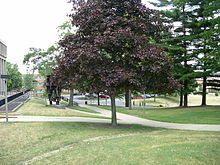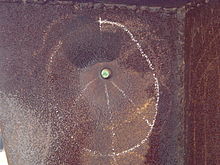Contagious shooting
This article may need to be rewritten to comply with Wikipedia's quality standards. (September 2020) |
A contagious shooting is a sociological phenomenon observed in military and police personnel, in which one person firing on a target can induce others to begin shooting. Often the subsequent shooters will not know why they are firing, unless they are infantrymen, in which case they are expected to do so. For instance, if someone was a member of a fire team following the point man and he suddenly begins firing his weapon, there is a good chance that their element is in contact with the enemy. Prerequisites for a sworn peace officer regarding the discharge of a duty weapon are in no way comparable to those of a military unit engaged in a firefight.[1][2][3]
While commonly accepted in popular culture and police jargon, there has been yet no scientific evidence "to prove the existence of a contagious shooting dynamic", which O'Donnell said was a "debatable notion".[4]
Additionally, a former CIA employee and FBI firearms instructor observed it in training. "Consistently, in every class, officers would shoot at their target upon hearing others shoot, even when their particular target board did not contain the called target."[5] He suggests that one reason it occurs is because of muscle memory: "[T]he targets turn, or the whistle blows, and all the officers shoot together until a cease-fire signal is given."
O'Donnell partially reinforces this, saying that in classic cases involving contagious shooting, "a gun was shot before any officers fired", and thus "the officers involved began shooting because of fear or because of the sound of a colleague firing".[4]
Examples[]
- 2013: In California, officers involved in the search for Christopher Dorner mistakenly fired at least 100 rounds at a truck occupied by three people, none of whom had any connection to the suspect.[6] Each of the two women injured received $2.1 million in a settlement with the city of Los Angeles.
- 2012: NYPD officers responded to a report of shots fired with one victim killed in front of the Empire State Building. Officers fired sixteen rounds, wounding 9 bystanders and killing the shooter.[7]
- 2011: On Memorial Day in Miami Beach, several police officers fired until their magazines were empty on a stopped car after the driver smashed into other cars, killing the driver and injuring seven bystanders.[8]
- 2010: A bystander was injured in Harlem when a man "open[ed] fire on responding officers, who fired 46 times in response".[4] "In the Harlem episode, unlike the Bell and Diallo cases, a gun was shot before any officers fired, according to the police account. So, Professor O'Donnell said, in the Harlem case, 'there really is a shot,' and not just the threat of gunfire."[4]
- 2009: A man threatening officers with a rifle was shot 59 times in what was ruled a "suicide-by-cop"[9] in Chattanooga, Tennessee.
- 2006: Five officers fired 50 shots at Sean Bell in Queens, New York, including 31 by one detective—who reloaded his weapon during the incident.[2][4][10]
- 2006: Three officers fired 26 shots at a pit bull that had bitten a chunk out of an officer's leg in the Bronx, New York, in July.[11]
- 2006: Police in Lakeland, Florida, fired 110 rounds at a suspect, Angilo Freeland, who had killed an officer earlier, hitting him 68 times. Polk County Sheriff Grady Judd told the Orlando Sentinel, "That's all the bullets we had".[12]
- 2005: Eight officers fired 43 shots at Brian Allen, an armed man in Queens, New York, killing him.[13]
- 2005: June, six Los Angeles County, California sheriff's deputies fired more than 50 shots into the car in which drunken driving suspect Carl Williams was driving after his car rammed a police vehicle following a chase. One deputy had to reload his weapon during the incident.[14]
- 2004: "When 44-year-old drug suspect Winston Hayes' SUV lurched forward, he hit a police car, deputies unloaded their weapons, firing 120 shots. Four bullets ended up hitting Hayes, who survived, one hit a deputy sheriff, 11 hit patrol cars, and 11 hit five homes in the neighborhood (one of them ended up tearing a hole in a homeowner's hat)." —ABC News.[14]
- 1999: Four officers fired 41 shots at Amadou Diallo, an unarmed man in the Bronx, New York, on February 4, 1999.[4][15][16]
- 1998: New Jersey State Police fired 11 shots at Daniel Reyes and three other basketball players in their car in April.[17]
- 1970: May 4. Kent State shootings: At 12:24 pm,[18] according to eyewitnesses, a Sgt. Myron Pryor turned and began firing at the students with his .45 pistol.[19] A number of guardsmen nearest the students also turned and fired their rifles at the students. In all, 29 of the 77 guardsmen claimed to have fired their weapons, using a final total of 67 rounds of ammunition. The shooting was determined to have lasted only 13 seconds, killing 4 students and wounding 9, although John Kifner reported in The New York Times that "it appeared to go on, as a solid volley, for perhaps a full minute or a little longer".[20] The question of why the shots were fired remains widely debated.Photo taken from the perspective of where the Ohio National Guard soldiers stood when they opened fire on the students
Usage[]
- The New York Times; August 12, 2010; Defined as "officers firing because others are doing so… The simplest culturally accepted definition … is that 'cops shoot because other cops shoot.'"[4]
- United Press International; November 27, 2006; Police experts had suggested "contagious shooting" may have played a role in a deadly New York incident when five officers fired 50 rounds at a man.
- The Baltimore Sun; May 24, 2006; "If one fire,, the rest fire. It is called contagious shooting," Mamet said. "People start shooting; they don't even know why."
- The New York Times; March 26, 1999; "Some law enforcement officials said that it was possible that only one or two of the officers perceived a danger, and that the others opened fire simply because their comrades had begun firing—a phenomenon known in law enforcement circles as contagious shooting."[15]
- New York Daily News; March 10, 1999; "A lawyer for one of four cops who shot Amadou Diallo hinted yesterday that a phenomenon known as "contagious shooting"—in which a cop's shot sparks a volley from other officers—may have caused his client to fire 16 shots... According to the NYPD patrol guide, a contagious shooting occurs when "a shot fired by one officer sets off a chain reaction of shooting by other personnel … Thomas Reppetto, head of the Citizens Crime Commission, said the term contagious shooting was used during 1960s riots when a cop would fire at what he thought was a sniper and other officers would follow."
See also[]
References[]
- ^ Michael Wilson (November 27, 2006). "50 Shots Fired, and the Experts Offer a Theory". The New York Times.
- ^ a b Gardiner, Sean (December 5, 2006). "Guns Gone Wild; NYPD gunfire goes up while crime goes down. What gives?". Village Voice. Archived from the original on September 26, 2007. Retrieved 2007-09-25.
The phrase NYPD officials have been using to describe why five officers would then shoot 49 more bullets into a car without anyone shooting back is "contagious fire": cops shooting because their partners are. It's what happened on the night of February 4, 1999, in the Bronx, when police officers assigned to an anti-gun squad struck Amadou Diallo with 19 of the 41 shots they fired.
- ^ Layton, Julia. "Can "contagious shooting" explain what happened in New York this weekend?". How Stuff Works. Retrieved 2007-09-25.
Some experts are calling the most recent incident in Queens an example of "contagious shooting," which might at least partially explain many other examples of apparent over-firing. The phenomenon seems to be a combination of reflex, panic and trust. In an article in the Baltimore Sun, law-enforcement consultant Edward Mamet explains, "If one fires, the rest fire ... People start shooting; they don't even know why."
- ^ a b c d e f g Rivera, Yar & Baker, Al (August 12, 2010). "Bystander Injured in Harlem Episode Cites 'Contagious Shooting' in Plan to Sue". The New York Times. p. A27. Retrieved 2010-08-27.
- ^ Chuck Joyner (29 Jan 2010). "Fighting the contagious fire phenomenon". PoliceOne.com. Retrieved 28 Apr 2013.
- ^ Michael Winter (23 Apr 2013). "2 women hurt during L.A. manhunt to receive $4.2M". USA Today. Retrieved 28 Apr 2013.
- ^ "Empire State Building shooting leaves 2 dead, 9 injured". Daily News. New York.
- ^ "Police Gunmen Open Fire On South". Archived from the original on June 3, 2011. Retrieved June 7, 2011.
- ^ "6 officers fired 59 shots in 'suicide by cop' case". 5 August 2009.
- ^ New York Post; November 26, 2006; A Queens bachelor party turned into a bloodbath early yesterday when five cops opened fire on a car with 50 shots - killing the groom-to-be, wounding his two friends and leaving furious relatives demanding answers from the NYPD.
- ^ Santos, Fernanda (July 24, 2006). "4 Officers Hurt (One by Pit Bull) as Police Fire 26 Shots to Kill Dog in Bronx". The New York Times.
- ^ Mikkelson, David. "Suspect Shot 68 Times by Police".
- ^ Rashbaum, William K. (January 8, 2005). "Police Say Man They Shot Terrorized 2 Co-Workers". The New York Times.
Man who died in a fusillade of more than 40 police bullets in Queens on Thursday had shot and wounded one deaf co-worker and kidnapped and raped another hours before the fatal confrontation, the police said yesterday
- ^ a b Baram, Marcus. How Common Is Contagious Shooting? ABC News. Nov. 27, 2006.
- ^ a b McFadden, Robert D. (March 26, 1999). "Lawyer Says 4 Officers Accused of Second-Degree Murder". The New York Times. Retrieved 2006-11-29.
Some law enforcement officials said that it was possible that only one or two of the officers perceived a danger, and that the others opened fire simply because their comrades had begun firing – a phenomenon known in law enforcement circles as contagious shooting.
- ^ Saletan, William (November 30, 2006). "Catch and Shoot. The perils of 'contagious shooting'". Slate. Retrieved December 1, 2006.
In the Diallo era, the NYPD patrol guide explained that the first shot 'sets off a chain reaction of shooting by other personnel.'
- ^ Hanley, Robert (June 2, 2000). "Troopers' Version of Shooting Is Disputed". The New York Times.
Two New Jersey state troopers who face trial in the 1998 shooting of three minority men in a van on the New Jersey Turnpike told the authorities they shot in self-defense as the van backed toward one of them. But the state released a court document Wednesday in which one of the men, Danny Reyes, said he had raised his hands and was pleading as a trooper shot him four times.
- ^ "May 4th Memorials". Kent State University. Archived from the original on May 8, 2010. Retrieved February 24, 2010.
- ^ "TRIALS: Last Act at Kent State". Time. September 8, 1975. Archived from the original on November 7, 2012. Retrieved August 18, 2011.
- ^ John Kifner (May 4, 1970). "4 Kent State Students Killed by Troops". The New York Times. Retrieved May 5, 2010.
- ^ McDonald, Kyle (April 21, 2014). "Full History of Familiar Kent State Sculpture Comes to Light after Decades". Record-Courier. Retrieved May 1, 2014.
External links[]
- Law enforcement terminology
- Police brutality
- Victimology
- 1990s neologisms
- Crowd psychology
- Popular psychology

